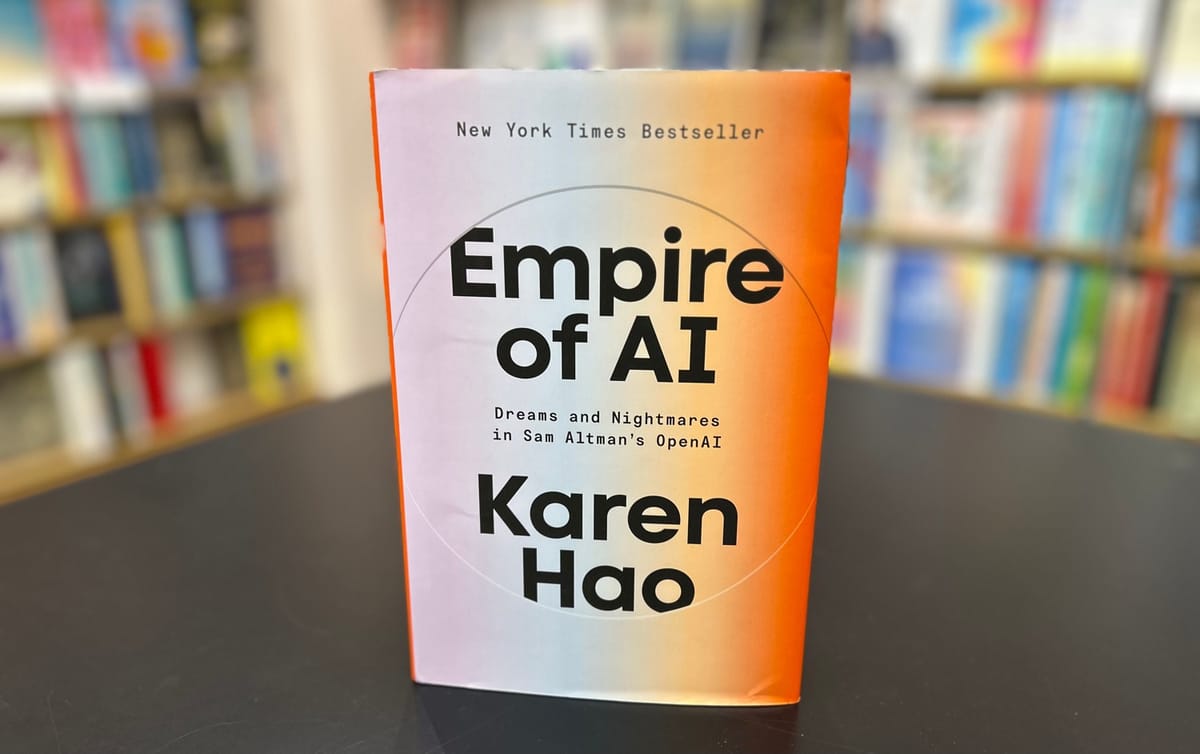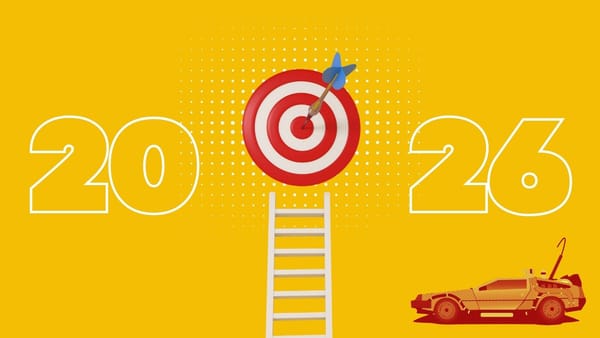We Need to Talk About AI
Karen Hao’s masterful new book reveals the ugly truth behind the hype

I sighed in shock, at least a half-dozen times throughout, as I listened to the audio version of Karen Hao’s new book, Empire of AI. I was shocked, dumbfounded, flabbergasted—not just by the names, faces and exploits of the geniuses behind the rise of so-called “artificial intelligence”, but by the cavalier way these leaders treat the technology, the planet, and the people whose lives they exploit to build it.
Hao’s book is not only a heroic exposé of Silicon Valley hubris but also a vivid reminder that what is being sold to us as “intelligence” is, in fact, a messy human endeavor, driven by the raw pursuit of profit, hype, and power. Hao knows. She’s been following the antics of AI World for years and documenting their curious behavior in articles for The Atlantic. She’s abundantly credible and her book is exquisitely sourced. If you want to understand the forces shaping our technological future—and the massive risks of leaving it in these people’s hands—you need to read this book. Ignore it at your own risk.
What they don’t want you to know
Before reading Empire of AI, I knew names like Sam Altman only vaguely. I watched him in interviews that always left me cold and suspicious. How can someone claim that a technology may gobble up the world and yet be so busy and eager to speed the human race down the road to that destruction? It didn’t add up, that is, until I finished this book.
Hao paints Altman, and his confederates, in brilliant technicolor—wicked smart, manipulative, power-hungry, even abusive, and often reckless (and dare I say it, sometimes dumb). What startled me most was not just their naked ambition but also their eager willingness to bend (or break) truth and governance to fit their aims. For instance, we learn that Altman quietly owned something called the OpenAI Startup Fund himself, a fact that shocked his own board when they discovered it. Later, directors concluded that he was “not consistently candid” about the organization’s commitments and legal structures. That was a giant understatement. And it was no isolated oversight; it was part of a broader pattern of secrecy and control, and of Altman’s penchant for using people and resources to utterly selfish ends.
These revelations force us to rethink the cheerful, prosocial public image of these innovators (or “monsters,” as Trump called them last week during a White House dinner with all the usual suspects at the table). Hao shows us that the charismatic leaders of AI are not philosopher-kings guiding humanity forward. We should call them by their true name: colonizers.
A confederacy of incredibly unserious people
Hao documents a culture that often treats monumental risks with shocking flippancy. OpenAI’s chief scientist, Ilya Sutskever, is quoted saying the company would “definitely” build a bunker before releasing artificial general intelligence (or AGI by its initials)—and even compared AGI’s arrival to “the rapture.” That doesn’t sound like the language of sober stewards; rather, it smacks of the rhetoric used by religious zealots.
Inside the company, the mythology went further. As lore has it, Sutskever once led employees in chanting “Feel the AGI!” and even had them burn a wooden effigy of an “unaligned AI.” What should be scientific caution too often took the appearance of a cult ritual, complete with all the inherent excesses.
And it went beyond symbolic antics. We also learn how a tiny bug in reinforcement learning code once caused an AI model to generate wildly pornographic content. Engineers joked grimly: “Let’s not make a utility minimizer.” This is cavalier experimentation at scale, carried out by people racing ahead without fully understanding the Frankenstein they’ve unleashed.
The illusion of intelligence
One of the book’s central points is to reveal a basic truth: these machines are not intelligent. They cannot run on their own. They require constant human intervention—millions of hours of intense, hidden human labor.
This was perhaps the biggest shock for me. The illusion that ChatGPT and its cousins are self-sufficient machine geniuses collapses when you see the global labor infrastructure propping them up. Hao details how workers in places like Kenya were paid less than $2 an hour to sift through toxic, traumatizing material (including scenes of highly graphic sexual content, violence and toxic hate speech) so that models would “learn” what not to produce. Similarly, in countries like Venezuela, desperate people clicked, tagged, and labeled endless streams of data, transforming human suffering into Silicon Valley’s AI “magic.”
The companies would rather you believe these systems are autonomous. But the reality is exploitation, not automation.
AI is not new—just newly scaled
Another myth Hao dismantles is that AI is some dazzling new invention. In truth, the concept dates back nearly seven decades. The first chat bot, called ELIZA, appeared in the mid 1960’s. Supercomputers, large datasets, and statistical models have been with us for many years. What’s new today is the raw compute power—thanks largely to powerful new processors, like those produced by chip maker NVIDIA—that allows companies to crunch unimaginably massive datasets, quickly.
In other words, the current AI boom is less about conceptual breakthroughs than about industrial scaling. OpenAI insiders even referred to their advantage as the “secret on a grain of rice”: scale is everything, and scale requires massive compute. This insight fuels both the secrecy and the arms-race mentality across the industry.
The fake debate: Boomers vs Doomers?
Another eye-opening aspect of Hao’s book is the dissection of what she calls the almost fake debate between AI “boomers” (who promise a golden age of productivity) and AI “doomers” (who predict human extinction). Both sides, she suggests, are missing the point. The real danger is not the machines themselves but the people wielding them.
The technology is not going to destroy us spontaneously. What’s dangerous is when flawed humans—greedy, careless, or malicious—command and entrust all to these systems. That is what Hao makes chillingly clear: our greatest threat is still ourselves.
An operating system of racism and misoginy
One of the hardest punches in Empire of AI is Hao’s unflinching account of how racism, prejudice and even misoginy run through the core of these systems and the corporate cultures that create them (at Open Ai, Goodgle, etc). The bias isn’t a bug—it’s the worldview of their tech bro creators, baked right into the code. Models spit out associations that cast people of color as criminals or victims while casting whiteness as power and leadership.
And when critics at these organizations raised alarms, they were dismissed or silenced. Hao shows how voices like Timnit Gebru’s, who was one of the co-authors of the influential paper titled, "On the Dangers of Stochastic Parrots: Can Language Models Be Too Big?" were sidelined, not because the evidence was weak, but more likely because fixing racism slowed the zealous march toward profit.
Meanwhile, the “safety work” of scrubbing slurs, violence, and racist bile out of these models fell to underpaid workers in Kenya, Venezuela, and beyond—mostly Black and brown people enduring psychological trauma, for mere pennies when you consider the billions, if not trillions, of dollars these companies are competing to attract. It’s painful to think that the people most harmed by these innate biases are also the ones cleaning up after it.
Is that oversight? Or simply disdain?
Empire, exploitation, and ecology
But wait—there’s more! The title Empire of AI is no poetic flourish. Hao shows how the industry reproduces colonial patterns. Workers in the Global South provide cheap labor; communities in Chile face the threat of water shortages because data centers may guzzle their supply; meanwhile billions of dollars in value flow back to Silicon Valley investors.
This may be empire in the 21st century: domination through data and compute, extraction of resources both human and natural, all justified under the banner of “progress.” But the ecological costs are staggering. Hao cites warnings that AI’s growth could add “several Californias” worth of electricity demand to the global grid. What is presented as sleek, digital innovation is in reality a profoundly physical, resource-hungry industry. And yet, despite all that, the leaders of these companies actually have the hutzpah to say that AI can be the answer to the global climate threat!
The messy reality of ChatGPT
One of my favorite aspects of the book is Hao’s detailed, behind-the-scenes chronicle of how ChatGPT 2, 3, and 4 came into being. Forget the marketing gloss about elegant breakthroughs. The process was messy, dirty, abusive, and often careless. In fact, it was also unexpected!
ChatGPT itself was launched almost casually, as a low-key research preview. Some safety researchers didn’t even realize it had been released until the world was already using it. Hao also reveals that the LLM model behind Chat GPT was just one of many Hail Mary projects in the early Open AI portfolio. And when it was released, servers buckled and guardrails lagged behind. And yet, the product exploded into the fastest-growing consumer app in history. Was that luck or a strike of genius? Or both?
Regardless, Hao shows how chaos, hype, and opportunism—not careful planning—gave us the chatbot that now shapes global discourse.
Copyright, theft, and the myth of progress
Another revelation: how training data is gathered. These models are not fed carefully curated, legally licensed corpora. They scrape anything and everything—articles, books, voices, music, art—more often than not without consent. Your words, my words, the creative output of millions of people are vacuumed up with impunity.
We have to ask, is this progress or is it sanctioned plunder? Hao makes clear that AI companies operate in a legal gray zone, racing ahead faster than regulation or lawmakers can catch up.
The bigger picture
If Hao’s revelations weren’t enough, the timing of her book makes them all the more urgent. Empire of AI tells the story of how Silicon Valley’s empire has intertwined itself with governments around the world—what she calls “OpenAI for Countries.” The strategy is clear: court presidents, prime ministers, and regulators so that corporate power becomes indistinguishable from state power.
And then, in the real world—not very long after the book landed—we saw a chilling echo. Donald and Melania Trump hosted Silicon Valley’s biggest stars just last week at the White House. Mark Zuckerberg, a newly minted but powerful AI contender, sat immediately to Trump’s right, but also present were Bill Gates (from Microsoft, the main bankroller of Open AI), Tim Cook (from Apple, another OpenAI collaborator), Sam Altman (from Open AI itself), and Sundar Pichai (from Google, the “OG” of the current crop of AI models)—a tableau of wealth and power in cozy alignment with political authority and pseudo fascism. That scene wasn’t in Hao’s book, but it might as well have been. It was the Empire of AI playing out in real time.
To Hao’s credit, Empire of AI is not a tale of doom and gloom. She makes space for stories of AI done right, as a tool to enhance our humanity instead of threatening it. She sheds light on an indigenous-driven effort in New Zealand to use AI to help save the Māori language, which is rapidly declining due to historical colonization and assimilation policies. The project developed AI tools such as speech recognition models and pronunciation feedback systems. This initiative allowed the Māori community to reclaim digital space for their language while ensuring data sovereignty—community control over their own linguistic data to prevent misuse. Hao presents this example as a powerful demonstration that AI can indeed be built by and for the people it is meant to serve, in stark contrast with the dominant corporate AI model of colonial empire-building.
Ultimately, Hao’s book is a gift and is likely the best business book of 2025, at least by my count. It’s enlightening, shocking, and ultimately serves as a courageous and unflinching account of the unsavory practices of the leaders behind the AI hype. Hao dares to imagine a brighter path for this technology because the way in which AI develops is not inevitable. We, the humans, are in control. But first, we need to understand what we’re dealing with. If you’re seeker of the truth, and want to inoculate yourself and your business against AI’s viral hype, this book is the perfect medicine.




